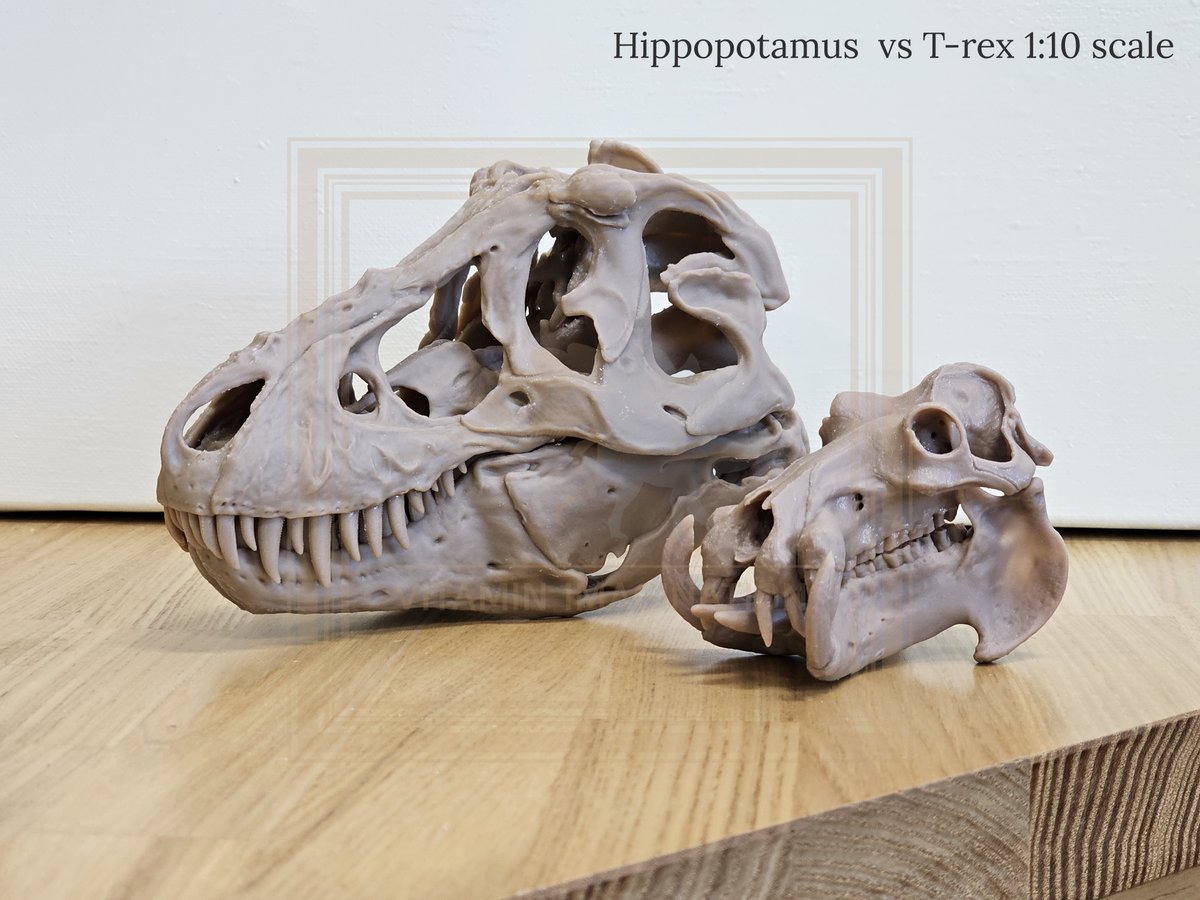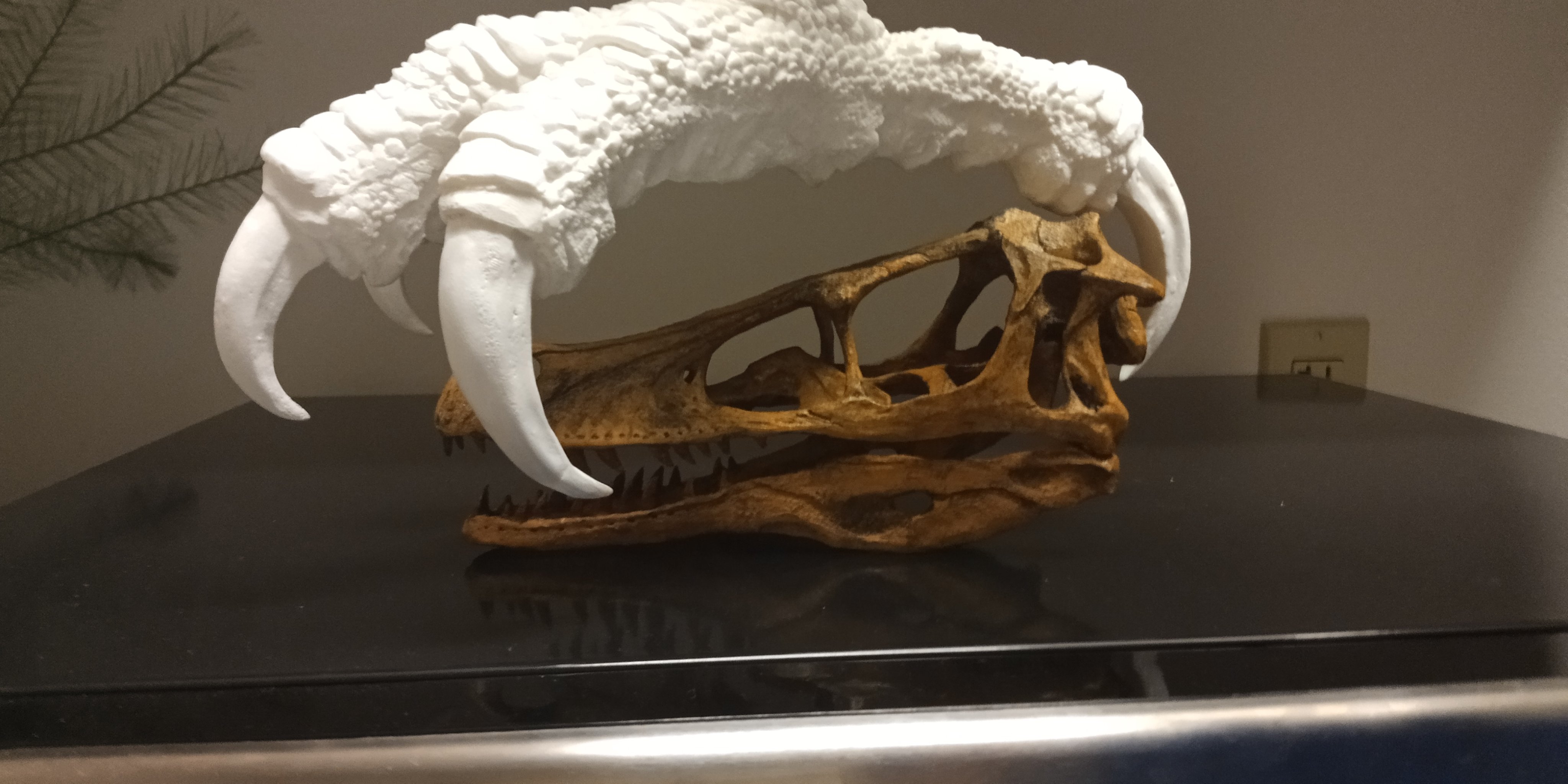|
|
Post by Exalt on Sept 7, 2023 2:41:22 GMT 5
So is Barinasuchus legitimately "nearly the same size" as Allosaurus, or is wool being pulled here?
I do think it is easy to lose track of how big things actually are, at times. I was reminded not too long ago about how large lions and tigers actually are, and I think that it plays into the bipedal vs non-bipedal thing. I don't know if it's some weird perception trick or what
|
|
|
|
Post by Supercommunist on Sept 7, 2023 4:42:54 GMT 5
The highland giant, my favorite sauropodomorph. I can't help but feel that 10 tonnes is a bit of an underestimate. I know it's got a long, relatively thin neck and a small head but I thought it would a few tons heaviers. Edit: Didn't realize attachments were that small. I embedded the image.  Attachments:
|
|
|
|
Post by theropod on Sept 7, 2023 5:49:51 GMT 5
Still waiting for that guy to finally be formally described, it’s been a while! So is Barinasuchus legitimately "nearly the same size" as Allosaurus, or is wool being pulled here? I do think it is easy to lose track of how big things actually are, at times. I was reminded not too long ago about how large lions and tigers actually are, and I think that it plays into the bipedal vs non-bipedal thing. I don't know if it's some weird perception trick or what
Well that depends on what one considers as "nearly the same size", and on how large other Barinasuchus specimens are (I don’t know any size estimates for them, I assume the specimen illustrated in the comparison is supposed to be the holotype). Given that the holotype is about average-sized, and that Allosaurus (supposedly scaled at 8.5 m in that comparison) is roughly average-sized too, then yes, it is pretty close. Barinasuchus definitely reached a size within the range of adult Allosaurus specimens, which is impressive enough for a Cenozoic land predator (which are otherwise at most cute little mammals like Daeodon or Arctodus). I very much doubt it ever reached the size attested to by the largest Allosaurus specimens (or indeterminate "Allosaurid" species?) though, as then we wouldn’t be talking about 1.5-2 t, but rather about 8-9 t. But those may not necessarily be the same species as the A. fragilis and jimmadseni specimens more commonly used to represent the genus, if they are even within the genus at all (which rumours say they may not be after all). And either way, they are freakishly, outlandishly large compared to the normal-sized Allosaurus specimens that we know (all the best-preserved skeletons are between 7 and 9 m long), so I don’t think that’s an entirely fair comparison to make. So generally yes, I could roll with the statement that Barinasuchus was Allosaurus-sized.
|
|
|
|
Post by Exalt on Sept 7, 2023 6:43:24 GMT 5
Still waiting for that guy to finally be formally described, it’s been a while! So is Barinasuchus legitimately "nearly the same size" as Allosaurus, or is wool being pulled here? I do think it is easy to lose track of how big things actually are, at times. I was reminded not too long ago about how large lions and tigers actually are, and I think that it plays into the bipedal vs non-bipedal thing. I don't know if it's some weird perception trick or what
Well that depends on what one considers as "nearly the same size", and on how large other Barinasuchus specimens are (I don’t know any size estimates for them, I assume the specimen illustrated in the comparison is supposed to be the holotype). Given that the holotype is about average-sized, and that Allosaurus (supposedly scaled at 8.5 m in that comparison) is roughly average-sized too, then yes, it is pretty close. Barinasuchus definitely reached a size within the range of adult Allosaurus specimens, which is impressive enough for a Cenozoic land predator (which are otherwise at most cute little mammals like Daeodon or Arctodus). I very much doubt it ever reached the size attested to by the largest Allosaurus specimens (or indeterminate "Allosaurid" species?) though, as then we wouldn’t be talking about 1.5-2 t, but rather about 8-9 t. But those may not necessarily be the same species as the A. fragilis and jimmadseni specimens more commonly used to represent the genus, if they are even within the genus at all (which rumours say they may not be after all). And either way, they are freakishly, outlandishly large compared to the normal-sized Allosaurus specimens that we know (all the best-preserved skeletons are between 7 and 9 m long), so I don’t think that’s an entirely fair comparison to make. So generally yes, I could roll with the statement that Barinasuchus was Allosaurus-sized.
Describing Arctodus and Daeodon like that sounds crazy, and yet in this context, it sort of works. I try not to use terms that could be interpreted derogatorily, but many theropods were freaks.
That said, iirc, when I was comparing Barinasuchus to Arctotherium Angustidens, the latter bear was only a couple hundred pounds fewer. I double checked it now, and the latter's estimates have a much larger gap between smallest and larger than what Barinasuchus has, so I don't know what I was getting before. But if I've learned one thing, it's don't bet on the high estimate.
I'm by zero means an Allosaurus expert. I almost expressed doubt that members of the same genus could have such a large size gap, but then I remembered...
But yes, I mean more in regards to the one above.
|
|
|
|
Post by theropod on Sept 7, 2023 7:25:14 GMT 5
Well yes. Species of one genus can have massive differences in size. Don't forget there are genera with hundreds of species, and that a genus is essentially a subjective concept that mostly exists in order to not run out of names for different species. Also think of the sizes of different species of Balaenoptera, or of Varanus, which differ far more than the largest and smallest Allosaurus specimens.
Even within a species, size ranges as large as within Allosaurus (from 7.3 m, 1.5 t Big Al and USNM 4734 to 8 or 9 ton AMNH 5767) are not unheard of, even if they are not the norm. The size range of adult Plateosaurus is similarly vast, ranging from less than 5 to about 10 m (although admittedly that likely isn't all one species either) . Adult white sharks range from a little over 3 m to 6 or 7 m. Adult sperm whales range from 10 m, 10 ton females to 20 m, 80+ males, with some possibly even larger (the maximum reported is 24 m).
|
|
|
|
Post by Exalt on Sept 7, 2023 7:48:24 GMT 5
"Don't forget" implies that I know more than I do. Thank you. I have some things to look up.
|
|
|
|
Post by Exalt on Sept 11, 2023 8:41:53 GMT 5
|
|
|
|
Post by Supercommunist on Sept 13, 2023 5:45:09 GMT 5
|
|
|
|
Post by Exalt on Sept 24, 2023 4:56:12 GMT 5
|
|
|
|
Post by Supercommunist on Sept 24, 2023 7:04:15 GMT 5
Crazy how its feet are nearly as long as its torso.
|
|
|
|
Post by Exalt on Sept 24, 2023 10:11:56 GMT 5
I frequently see people compare them to the claws of tiger. It practically feels like a tradition at this point.
|
|
|
|
Post by Infinity Blade on Nov 9, 2023 7:04:00 GMT 5
Wanna know how the skulls of a hippo and a T. rex look like to scale (images by Vitamin Imagination)?   |
|
|
|
Post by Infinity Blade on Dec 12, 2023 2:00:47 GMT 5
Haast's eagle foot above Velociraptor skull. Note that the hallux talon is actually behind the skull, so you can tell it's being held directly above it with no camera tricks (from Tarbtano->).   3D printed cast of Utahraptor's skull ( link->). Skull seems to be some 70 cm long.    |
|
|
|
Post by Shri devi on Jan 30, 2024 16:25:14 GMT 5
Haast's eagle foot above Velociraptor skull. Note that the hallux talon is actually behind the skull, so you can tell it's being held directly above it with no camera tricks (from Tarbtano->).   3D printed cast of Utahraptor's skull ( link->). Skull seems to be some 70 cm long.    Note that Jim Kirkland has told me on twitter that the skull in Scott Hartman's skeletal is a little bit too long and implied that the Rob Gaston mount is better in that aspect. Granted, all Utahraptor skull recons are based on a box of scraps and said scraps come from several different animals of varying sizes and possibly uncertain identification... Also, hi everyone, this is my first post here! I'm gonna quickly follow up this Eudromaeosaur skull comparison with another one, this one between D. antirrhopus and C. lupus, P. pardus and C. crocuta that I've seen float around either this and similar forums:  I think the Deinonychus skull here is meant to be 41cm and scaled to MCZ 4371. Outside of this image, I've also seen the 41cm number brought up elsewhere. The problem is that, as far as I can tell from a cursory look through Wikipedia, this number comes from GSP, and I'm not sure whether this was also when he lumped Deinonychus into Velociraptor and reconstructed it with an elongated Velociraptorine skull. Another anomaly with this image specifically in that it doesn't seem to resemble any of the common skull reconstructions, like the triangular one (from John Ostrom himself, I think?) or the rectangular one ala Scott Hartman. Regardless, all of those skull reconstructions are now outdated and I believe the most up to date one is from (Powers 2020): ![]()  This one is notably more short snouted than most preceding recons, especially the velociraptorine ones, which would most likely make the 41cm estimate an overestimate. This skull reconstruction by Powers is around 32 cm and scaled to the maxilla from YPM 5232 which as far as I can tell has no size estimate which makes sense given that it is only cranial material. I've quickly thrown together a comparison below with spotted hyena, jaguar and komodo dragon but with the Deinonychus skull scaled to YPM 5210 using the diagram of the jugal from the original description of Deinonychus (Ostrom 1969) (included in the comparison so you guys can check my work if you're so inclined).  ![]() I haven't really done a size comparison or proper skeletal scaling before so please critique the hell out of this. If I'm in the ballpark of being right though, then YPM 5210's skull wasn't too much larger than YPM 5232's, at around 33.75 cm. This still leaves Deinonychus with a skull larger than similar sized modern terrestrial predators. Back to MCZ 4371 though, since we don't have the skull for it but we do have postcrania from both it and YPM 5210, I wanna ask if anyone here is aware of any well-done size estimates for these two, to then see roughly how big the skull of MCZ 4371 was? ![]() |
|
|
|
Post by Shri devi on Jan 30, 2024 16:28:40 GMT 5
Lmao, idk why the images came out so small and compressed, still new here, I'm sure I'll figure it out.
|
|